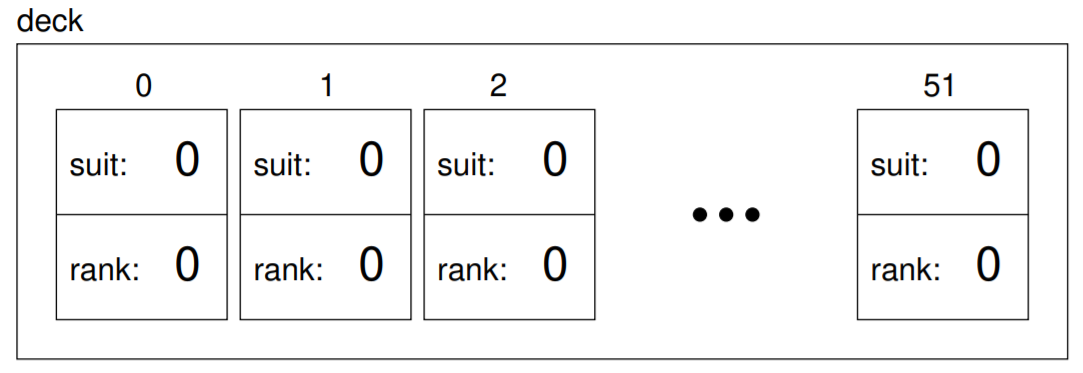12.6. Vectors of cards¶
The reason I chose Cards as the objects for this chapter is that
there is an obvious use for a vector of cards—a deck. Here is some code
that creates a new deck of 52 cards:
vector<Card> deck (52);
Here is the state diagram for this object:

The three dots represent the 48 cards I didn’t feel like drawing. Keep in mind that we haven’t initialized the instance variables of the cards yet. In some environments, they will get initialized to zero, as shown in the figure, but in others they could contain any possible value.
One way to initialize them would be to pass a Card as a second
argument to the constructor:
Card aceOfSpades (3, 1);
vector<Card> deck (52, aceOfSpades);
This code builds a deck with 52 identical cards, like a special deck for a magic trick. Of course, it makes more sense to build a deck with 52 different cards in it. To do that we use a nested loop.
The outer loop enumerates the suits, from 0 to 3. For each suit, the inner loop enumerates the ranks, from 1 to 13. Since the outer loop iterates 4 times, and the inner loop iterates 13 times, the total number of times the body is executed is 52 (13 times 4).
int i = 0;
for (int suit = 0; suit <= 3; suit++) {
for (int rank = 1; rank <= 13; rank++) {
deck[i].suit = suit;
deck[i].rank = rank;
i++;
}
}
I used the variable i to keep track of where in the deck the next
card should go.
Notice that we can compose the syntax for selecting an element from an
array (the [] operator) with the syntax for selecting an instance
variable from an object (the dot operator). The expression
deck[i].suit means “the suit of the ith card in the deck”.
This deck-building code is encapsulated in a function called
buildDeck that takes no parameters and that returns a
fully-populated vector of Cards.
Take a look at the active code below, which includes the implementation of
the buildDeck function.
- There are 16 cards in the deck.
- Correct! You can verify this by checking how many times the for loops execute.
- The deck is single-suited.
- Incorrect! Look at the conditions of the outer for loop, you'll find that there are two suits in this deck.
- There are no face cards in the deck.
- Incorrect! Look at the conditions of the inner for loop, you'll find that this deck contains face cards.
- The deck does not contain any Hearts.
- Correct! The two suits in this deck are Clubs and Diamonds.
- There are two Jacks in the deck.
- Correct! The deck contains the Jack of Clubs and the Jack of Diamonds.
Q-2: Take a look at the code below. What can we say about the deck that is created?
vector<Card> createDeck() {
vector<Card> deck (16);
int i = 0;
for (int suit = 0; suit <= 1; suit++) {
for (int rank = 4; rank <= 11; rank++) {
deck[i].suit = suit;
deck[i].rank = rank;
i++;
}
}
return deck;
}
Q-3: If we actually created the deck in the previous question, what is printed after the following code runs?
deck[11].print();
Type your answer exactly as it would appear in the terminal!